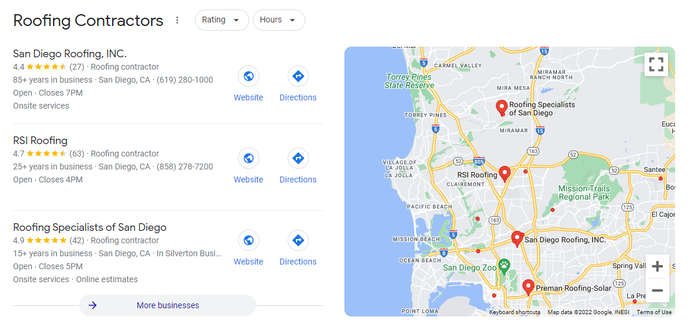Roofers—Build Your Online Presence Before the Sale
Many contractors believe that customer engagement begins when you receive a phone call, email, or text message. But it actually begins even earlier.

Any roofing contractor who’s been in business for many years knows that creating strong customer relationships is key to creating sustainable growth. Having happy, satisfied customers is the basis for developing credibility, trust, and opportunities for future business. And fostering effective communication with those customers throughout their interaction with your company is essential. How do you cultivate effective customer communication? It has to be implemented from the very first point of contact.
Many contractors believe that customer engagement begins when you receive a phone call, email, or text message. But it actually begins even earlier; BEFORE prospects have reached out to you. Let’s take a look at the primary touchpoints you may have with customers, from the beginning, throughout the job, and in becoming a loyal customer. We’ll discuss ways you can improve those points of interaction to create a stronger customer relationship.
What kind of experience are you creating for your customers? You might say that the quality of your work speaks for itself and that you are providing a solid customer experience. But did you know that the quality and frequency of your communication with homeowners might be an even stronger factor in converting them into happy customers?
Before the Job
Before the job begins, potential customers are searching for roofers like you to fix their problems, usually online. According to Think with Google, 80% of consumers use online search engines (like Google) to begin the process. . In this search, they’ll come across what’s known as the Google “three-pack”. In my area of San Diego, a search for “roofing contractor San Diego” brings me to this page:

Google Business Profile
You’ll notice that each of the businesses listed in this “three-pack” all feature online reviews, the number of years in business, business hours, along with location information and phone number. This may seem trivial, but this is important information that must be provided within the profile to rank effectively. Not only does it help the Google algorithm to assess your business listing, but it also demonstrates a commitment to details and shows a focus on professionalism. As the first point of contact, it’s critical that your business listing is claimed, accurate, and current to attract new customers. You can read about more ways to optimize your Google Business profile here.
Your Website
After prospective customers scan through Google Business listings, they check out individual websites for each business. This sounds like a very basic question, but do you have a website that describes what you do in words and pictures, who you serve, in what area, and provides an easy way for prospective customers to get in touch with you? Is it mobile-friendly? Your website speaks volumes about your commitment to customers, your work, and your mission. Prospective customers are forming an opinion about your company now and determining whether they want to engage with you.
Multiple Lead Channels
If that prospective customer has decided to shortlist your business, the next step is for them to contact you. It would generally be at a time that is convenient for them—not necessarily convenient for you and your team. Will you be available when they reach out to answer their questions? We’ve addressed how lead response time can affect a customer’s impression of your business, so it’s critical that you have a plan in place to capture incoming leads and be responsive to customers, even when you can’t answer the phone.
Homeowner Preferences
Consumers these days have wide-ranging preferences. It might be easier for them to text, message, or email your business. Or they may have detailed questions that are better suited to a phone conversation. At the start of your relationship with each customer, take the time to ask, “What’s the best way to stay in touch with you? Would you like us to call, email, or text you?” This simple question can go a long way in helping you communicate more effectively with your customers.
Estimate
One of the first activities is usually going to the home and gathering information to create an estimate. This can be viewed as a simple transactional meeting but it’s a great opportunity to shine. By paying attention to the details that the prospective customer has noted, and using tools like SumoQuote to compile a professional estimate, you can stand out in the crowd. Also, it’s important to use this opportunity to play the role of educator and make proactive recommendations within your estimate to give your customer options and demonstrate your understanding of the problem and the expertise to create a solution.
Remember, many homeowners may have never filed a claim for their roof or nailed a shingle. This is why they look to you as an expert, to guide them through the process. You can demonstrate that you understand their particular problem and understand the complexities of roofing terminology, insurance processes, timelines, cost and can apply your expertise to deliver the best solution possible.
Follow up to Estimate
This is where many sales reps fall down and many leads are lost. According to industry research, 80% of sales require five follow-up phone calls. However, 44% of salespeople give up after just one follow-up. If you are serious about closing more deals, this is one of the main areas of communication you can focus on now with a calculated approach and get measurable results.
Getting the Job
Implementing effective customer communication during the “kicking the tire” phase is essential to getting the job. But the need for demonstrating good customer communication is just beginning. As you move forward to the next stage of the buyer’s journey, it’s even more critical to get it right. In the next edition of this series, we’ll discuss what type of communication is essential when you get the job, and your communication strategy during the project for developing a positive customer experience.
About the Author(s)
You May Also Like




